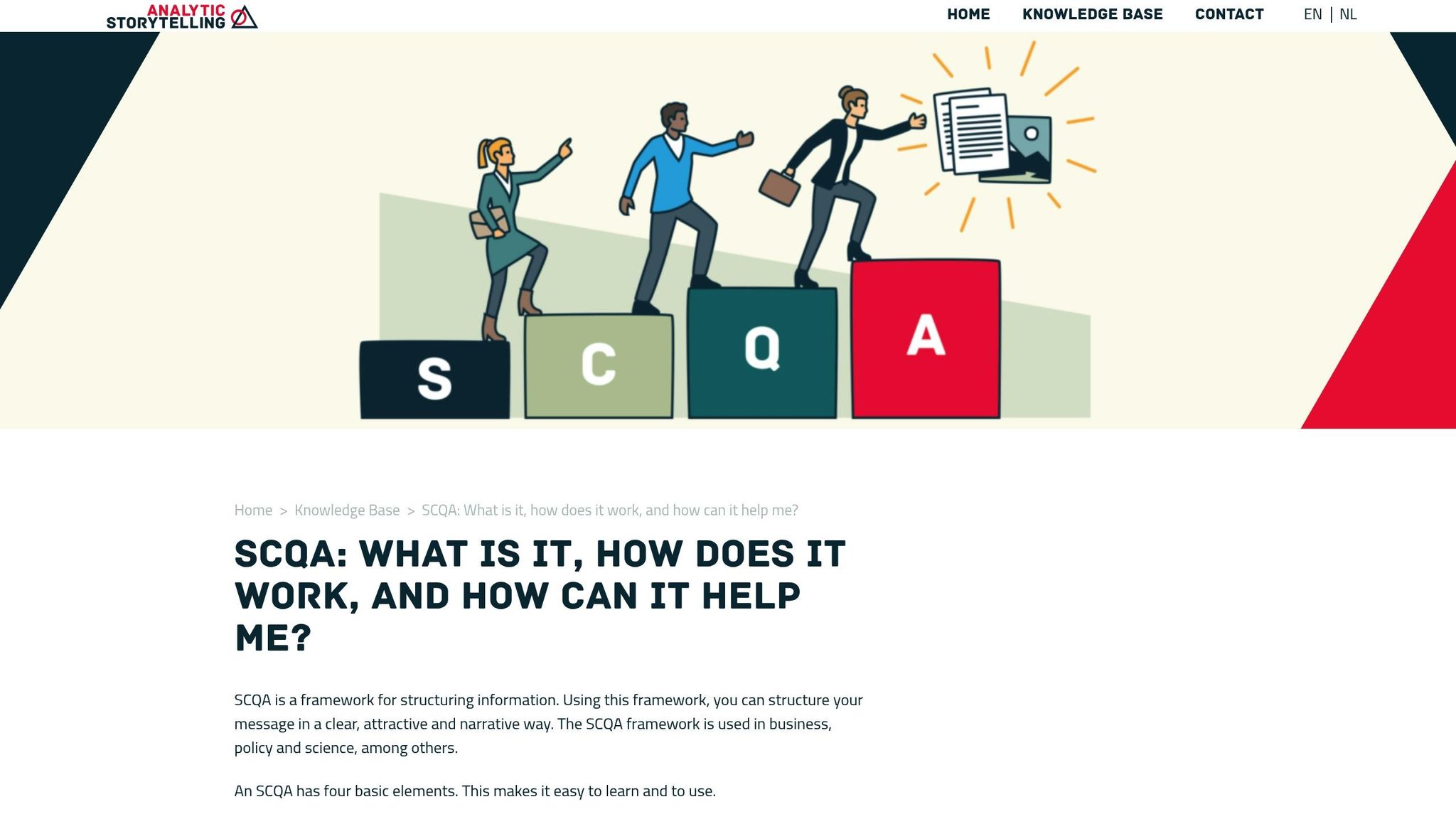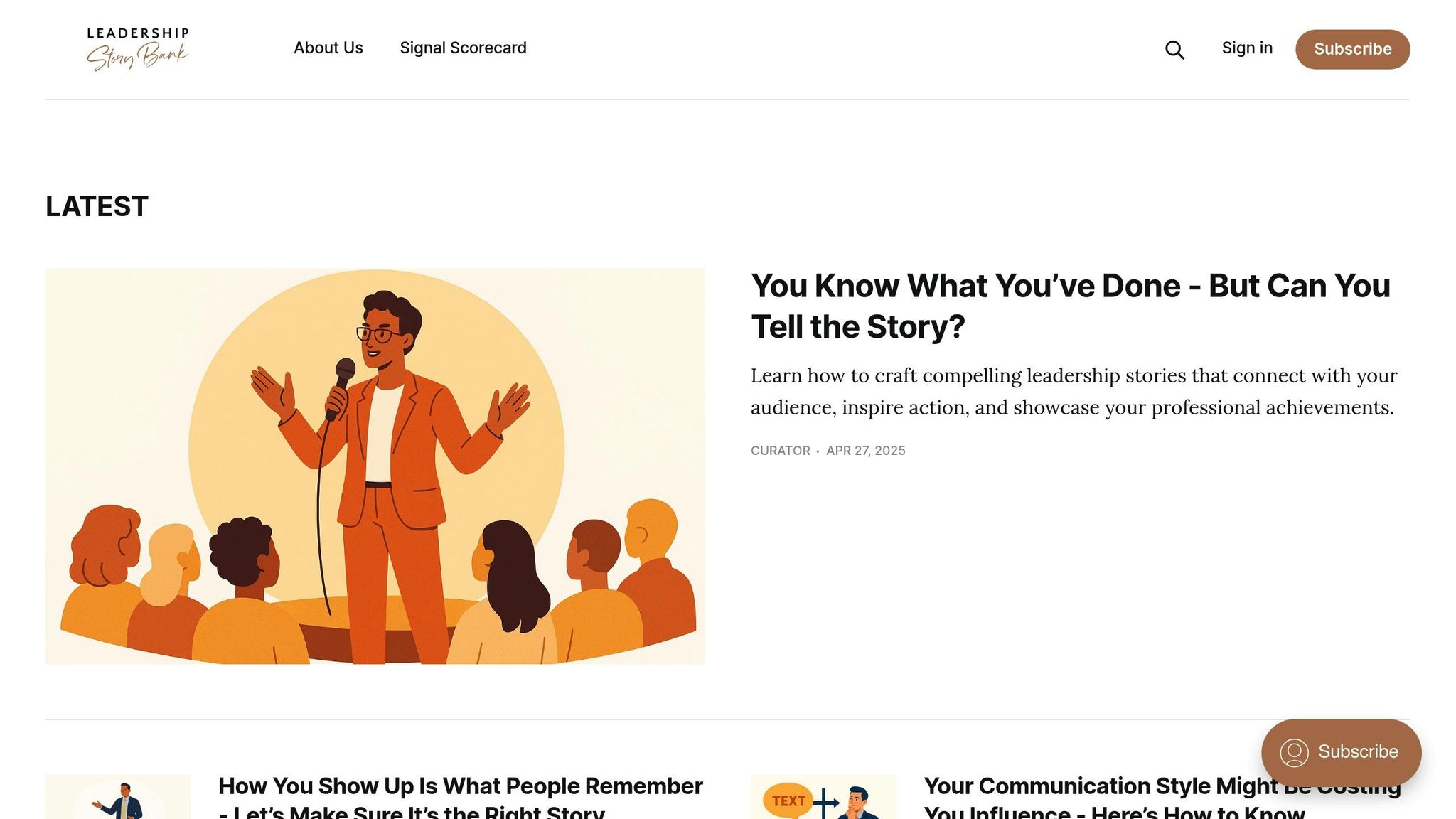SCQA Framework for Leadership Stories
Learn how to use the SCQA framework to craft compelling leadership stories that clarify messages, inspire teams, and drive action.

The SCQA framework is a simple way for leaders to turn complex ideas into clear, engaging stories. It helps structure messages to inspire teams, build trust, and drive action. Here's how it works:
- Situation: Set the scene with relevant context.
- Complication: Highlight the main challenge or problem.
- Question: Define the key issue that needs solving.
- Answer: Provide a clear solution and next steps.
This approach improves communication, speeds up decision-making, and aligns teams around shared goals. Whether you're explaining changes, pitching ideas, or planning strategies, SCQA ensures your message is clear and impactful.
| SCQA Part | Purpose | Common Pitfalls |
|---|---|---|
| Situation | Provides context | Too vague or technical |
| Complication | Highlights the problem | Listing too many issues |
| Question | Sharpens focus | Too broad or overly specific |
| Answer | Offers a solution | Missing key details |
Start small by practising SCQA in team updates or project meetings, and build a library of stories to refine your leadership communication.
Master the SCQA Technique: The Ultimate Storytelling ...

The 4 Parts of SCQA
The SCQA framework is made up of four key elements that help structure leadership stories effectively.
1. Situation: Setting the Scene
The Situation lays the groundwork by providing a clear and relatable context. It should:
- Clearly define the current state
- Include relevant background information
- Use specific details your audience can connect with
For example: "For the past ten years, our company has operated with five regional teams, successfully serving large customer bases across UK territories."
2. Complication: Introducing the Challenge
The Complication highlights the issue or disruption that needs to be addressed. This part should:
- Identify obstacles or changes
- Explain why the current approach no longer works
- Include evidence or observations to support the issue
"Recent feedback from customers indicates that many now operate across multiple regions. This has created communication bottlenecks and duplicated efforts between teams."
3. Question: Defining the Core Issue
The Question arises from the tension between the Situation and the Complication. A strong question should:
- Pinpoint the main challenge
- Convey urgency
- Lead the audience toward potential solutions
"How can we reorganise our teams to serve clients operating across multiple regions without sacrificing service quality?"
4. Answer: Offering the Solution
The Answer delivers a clear resolution to the Question. It should:
- Detail the actions and steps to be taken
- Address possible concerns
- Explain how success will be evaluated
"We are adopting a matrix organisation structure. Regional teams will continue to nurture local relationships, while new cross-functional teams will focus on multi-territory accounts. This approach aims to improve response times and streamline communication."
| SCQA Component | Purpose | Common Mistakes to Avoid |
|---|---|---|
| Situation | Provides context | Being too vague or overly technical |
| Complication | Highlights the problem | Listing too many issues at once |
| Question | Sharpens focus | Making it too general or overly specific |
| Answer | Offers a solution | Leaving gaps in the proposed plan |
Each part of the SCQA framework should flow logically into the next. This method helps break down complex leadership messages into a clear and structured narrative.
Next, explore how to craft your SCQA story using a simple three-step process.
3 Steps to Build Your SCQA Story
Creating an SCQA story takes careful thought and planning. Here's a straightforward approach to shaping your leadership narrative.
Step 1: Define Your Goal
Start by identifying a clear purpose. Think about what you want your story to achieve and how it ties into your leadership aims and your audience's needs.
Key points to consider:
- Desired outcome: What specific action or change are you hoping to encourage?
- Audience impact: How will your message resonate with your team or stakeholders?
- Measuring success: What indicators will show that your story has achieved its purpose?
For instance, if you're announcing changes to your department's structure, your goal might be to help your team understand the advantages while addressing concerns about job roles and security.
Once your goal is clear, gather the information needed to support your story.
Step 2: Gather Your Facts
Collect all the relevant data and insights that highlight the situation and any challenges. Make sure your evidence is accurate and well-organised to build trust and strengthen your narrative.
With your facts in place, you can now focus on defining the key issue and its solution.
Step 3: Frame Your Question and Answer
Develop a clear question that reflects your audience's primary concern. Then, provide a straightforward answer that motivates them to take action.
SCQA Framework: Benefits
The SCQA framework simplifies complex ideas by organising them into a clear, easy-to-follow narrative. By focusing on problems and their solutions, it helps leaders create stories that resonate with their audience.
Here’s what it can achieve:
- Speeds up decision-making and fosters alignment
- Encourages team engagement and commitment
- Clarifies accountability and drives action
- Creates lasting momentum for change
SCQA Results Table
| Aspect | Benefits |
|---|---|
| Narrative Structure | Offers a straightforward blueprint for effective storytelling |
| Logical Flow | Ensures stories are simple to follow and memorable |
| Problem-Solution Focus | Clearly presents challenges and their solutions |
| Audience Connection | Addresses audience concerns and encourages engagement |
These benefits build on the steps for creating your SCQA story and pave the way for using Leadership Story Bank tools to refine your message. When applied effectively, SCQA helps form meaningful connections that drive results.
Leadership Story Bank Tools for SCQA

Leadership Story Bank provides resources to help leaders craft SCQA narratives that connect with their audience and address challenges effectively.
Our Story Development Framework offers a clear structure for building SCQA narratives, guiding you step by step to ensure your message is both organised and impactful.
Tools to Strengthen Delivery
The platform includes tools to refine how you deliver your SCQA stories, such as:
- Techniques to improve your voice and delivery style
- Templates for analysing and understanding stakeholders
- Exercises to build confidence in storytelling
These tools equip you to tailor your narrative to suit various leadership situations.
Strategic Application Resources
Leadership Story Bank also helps you apply SCQA stories to specific scenarios. Here's how:
| Scenario | Focus Area | Outcome |
|---|---|---|
| Internal Collaboration | Aligning and motivating | Clear goals and shared purpose |
| Change Management | Problem-solution approach | Commitment and buy-in |
| Stakeholder Influence | Strategic communication | Credibility and support |
Turning Theory Into Practice
Beyond tools and frameworks, the platform offers guidance to:
- Highlight key story elements that engage your audience
- Develop a narrative style that feels personal and genuine
- Craft stories that inspire action and drive results
Leadership Story Bank bridges the gap between theory and practice, ensuring your SCQA narrative not only reflects your leadership vision but also motivates meaningful change.
Next Steps with SCQA
SCQA can improve leadership communication by connecting challenges to clear solutions. To get started, focus on leadership scenarios where it can have the most impact.
Start Small
Choose a straightforward leadership challenge, such as a team meeting or a project update, that requires a clear and focused narrative.
Practise and Improve
Test your story by recording yourself, practising with a colleague, and collecting feedback. This will help you make your message clearer and more effective.
Tailor to Different Situations
Adapt your SCQA stories to fit various leadership contexts:
| Context | Story Focus | Key Elements |
|---|---|---|
| Team Updates | Current challenges and solutions | Clear metrics and actionable steps |
| Strategic Planning | Future vision and roadmap | Data-backed insights and milestones |
| Change Management | Benefits and implementation | Specific timeline and support resources |
By documenting these tailored stories, you'll create a useful resource for handling future challenges.
Create a Story Library
Keep a record of successful SCQA stories and note what works well. Over time, this collection will become a valuable tool for addressing different leadership needs.
Track Results
Monitor the impact of your stories by evaluating team engagement, how well solutions are implemented, feedback from stakeholders, and the outcomes achieved. Update your narratives as situations evolve, and use the Leadership Story Bank framework to keep improving your communication.
FAQs
How can I use the SCQA framework to enhance my leadership communication?
The SCQA framework is an excellent tool for structuring leadership communication in a way that captures attention and delivers a clear message. To integrate it into your strategy, start by identifying the Situation - the context your audience is familiar with. Then, outline the Complication - the challenge or issue that needs addressing. Follow this with the Question - the key problem your communication aims to solve. Finally, present the Answer - your proposed solution or perspective.
By using this framework, you can create leadership stories that are both engaging and impactful. It helps you build a narrative that resonates with your team and stakeholders, ensuring your message is clear and compelling. Whether you're leading a team meeting, addressing change, or influencing stakeholders, SCQA can provide the structure you need to communicate with confidence and clarity.
What mistakes should I avoid when using the SCQA framework to create a leadership story?
When crafting a leadership story using the SCQA framework, there are a few common pitfalls to watch out for:
- Overloading with details: Including too much information can dilute your story's focus. Stick to the most relevant points to keep your audience engaged.
- Skipping the 'Complication' step: A compelling story needs a challenge or tension to resonate emotionally. Ensure you clearly articulate the issue or obstacle before moving to the resolution.
- Neglecting your audience: Tailor your story to the needs and interests of your listeners. A story that feels disconnected from the audience can fail to inspire or influence.
By avoiding these mistakes, you can use the SCQA framework to craft leadership stories that are clear, engaging, and impactful.
How can I evaluate the impact of a leadership story crafted with the SCQA framework on team engagement and outcomes?
To measure the success of a leadership story structured with the SCQA framework, focus on both qualitative and quantitative indicators of team engagement and outcomes.
Observe how your team responds during and after the story is shared. Look for signs of active listening, engagement, and emotional connection, such as thoughtful questions, discussions, or visible enthusiasm. You can also gather feedback through informal conversations or structured surveys to understand how the story resonated.
On a practical level, track specific actions or outcomes that align with the story's purpose. For example, if the story aimed to inspire collaboration, note whether team members demonstrate increased cooperation or take initiative in group projects. Combining these insights will help you gauge the story's effectiveness and refine your approach for the future.



